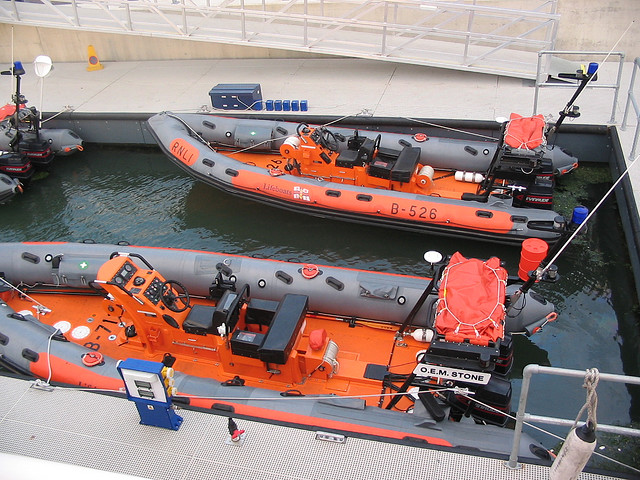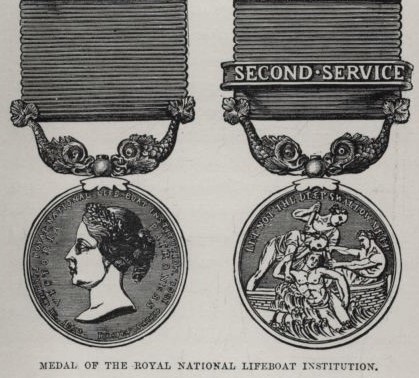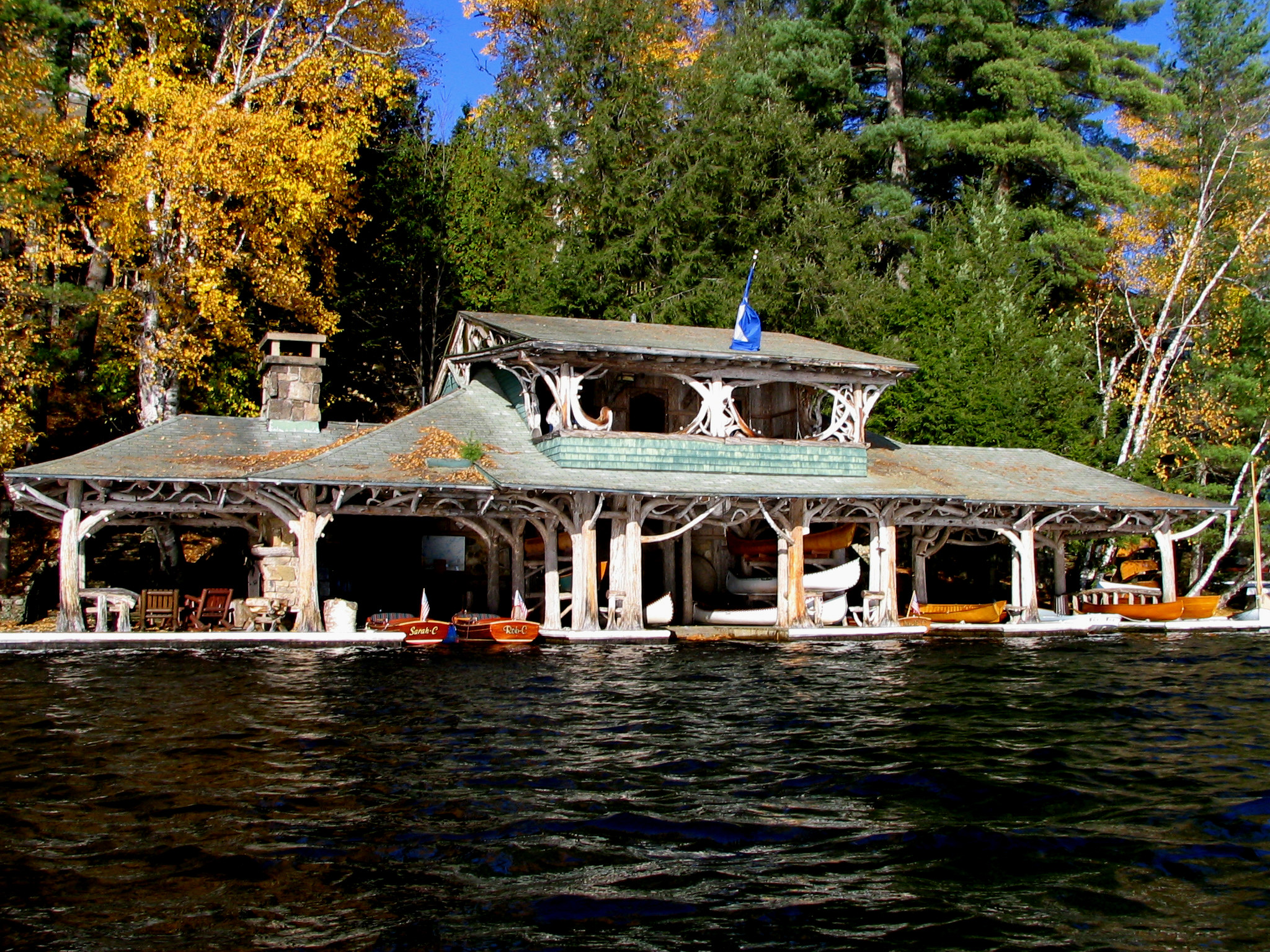|
Mudeford Lifeboat Station
Mudeford Lifeboat Station is the base for Royal National Lifeboat Institution (RNLI) search and rescue operations at Mudeford, Christchurch, Dorset in England. The first lifeboat was stationed on Mudeford Quay 1963 and the present station was opened in 2003. It operates an inshore lifeboat (ILB). History During the 1960s the RNLI deployed inflatable ILBs at places around the coast where a quick response to increasing numbers of leisure boats and water users could not be made by larger all-weather lifeboats (ALBs) at stations established to serve commercial shipping. Mudeford Quay, at the entrance to Christchurch Harbour, was selected as a suitable place and a small inflatable boat provided. This type of boat could only operate in relatively good conditions and were seldom used in the winter. As their usefulness was proven, some stations received an 'intermediate' ILB which could operate in more severe conditions. As early as 1970, Mudeford was one of the stations used to trial a ... [...More Info...] [...Related Items...] OR: [Wikipedia] [Google] [Baidu] |
England
England is a country that is part of the United Kingdom. It shares land borders with Wales to its west and Scotland to its north. The Irish Sea lies northwest and the Celtic Sea to the southwest. It is separated from continental Europe by the North Sea to the east and the English Channel to the south. The country covers five-eighths of the island of Great Britain, which lies in the North Atlantic, and includes over 100 smaller islands, such as the Isles of Scilly and the Isle of Wight. The area now called England was first inhabited by modern humans during the Upper Paleolithic period, but takes its name from the Angles, a Germanic tribe deriving its name from the Anglia peninsula, who settled during the 5th and 6th centuries. England became a unified state in the 10th century and has had a significant cultural and legal impact on the wider world since the Age of Discovery, which began during the 15th century. The English language, the Anglican Church, and Engli ... [...More Info...] [...Related Items...] OR: [Wikipedia] [Google] [Baidu] |
Atlantic 21 Class Lifeboat
The Atlantic 21 is part of the B class of lifeboats that served the shores of the United Kingdom and Ireland as part of the Royal National Lifeboat Institution (RNLI) inshore fleet. The Atlantic 21 was the first generation rigid inflatable boat (RIB), originated at and by Atlantic College in South Wales, the birth place of the RIB after which the craft is so named. The school was also one of nine locations where the RNLI first established lifeboat stations using smaller inshore watercraft. Atlantic College Lifeboat Station was commissioned by the RNLI in 1963 and decommissioned in 2013. Nearly all of the Atlantic 21s have been retired from service by 2006, one of the notable exceptions to this being the boat allocated to Walmer in Kent. RNLB ''James Burgess'' (B-589) was retired to the relief fleet in December 2006. It was replaced by an Atlantic 85. Description The Atlantic 21 can be launched from a davit, trolley or floating boathouse depending on the location of the stati ... [...More Info...] [...Related Items...] OR: [Wikipedia] [Google] [Baidu] |
List Of RNLI Stations
Royal National Lifeboat Institution (RNLI) stations are the bases for the RNLI's fleet of search and rescue lifeboats that cover the coastal waters around the entire British Isles, as well as major inland waterways. The service was established in 1824 and is operated largely by volunteers. Its headquarters are at Poole, Dorset and it is a registered charity in both the United Kingdom and Republic of Ireland. Key Lifeboat types The types of boats provided at each station and the launching methods vary depending on local needs. If more than one boat is provided they are sometimes stationed in separate buildings at different locations in the same town. Current RNLI boats fall into three broad groups: * All weather lifeboats (ALBs): , , , , and . * Inshore lifeboats (ILBs): , , and * Hovercraft: ''H''-class Launch methods The principal launching methods are: * Carriage – an ALB or ILB is pushed into the water on a carriage by a tractor * Davit – an ALB or ILB is ... [...More Info...] [...Related Items...] OR: [Wikipedia] [Google] [Baidu] |
C-class Lifeboat
The C-class lifeboats were Zodiac Grand Raid Mark IVs powered by twin 40 hp outboards and was formerly operated by the Royal National Lifeboat Institution of the United Kingdom and Ireland Ireland ( ; ga, Éire ; Ulster Scots dialect, Ulster-Scots: ) is an island in the Atlantic Ocean, North Atlantic Ocean, in Northwestern Europe, north-western Europe. It is separated from Great Britain to its east by the North Channel (Grea .... It was replaced by the D-class (EA16) and B-class (Atlantic 21). Fleet Notes References External linksRNLI Fleet Royal National Lifeboat Institution lifeboats Ship classes {{Water-sports-stub ... [...More Info...] [...Related Items...] OR: [Wikipedia] [Google] [Baidu] |
Awards Of The Royal National Lifeboat Institution
A number of Royal National Lifeboat Institution awards have been established by the Royal National Lifeboat Institution (RNLI) since its creation in 1824. None are approved by the Crown, and are therefore unofficial awards. As such, they do not appear in the official British order of wear, although the principal lifesaving award, the ''Medal of the RNLI'', can be worn on the right breast in uniform by members of the British armed forces. RNLI awards The RNLI awards include: Medal of the RNLI The medal was established in 1824, the same year the RNLI was founded, to reward "humane and intrepid exertions in saving life from shipwrecks on our coasts, deemed sufficiently conspicuous to merit honourable distinction". The medal can be awarded for saving life at sea in gold, silver and, since 1917, in bronze. While awards are now only made to lifeboat crew who risk their lives in rescue attempts, a number of nineteenth century medals were bestowed on others who saved life from the s ... [...More Info...] [...Related Items...] OR: [Wikipedia] [Google] [Baidu] |
Poole Lifeboat Station
Poole Lifeboat Station is the base for Royal National Lifeboat Institution (RNLI) search and rescue operations at Poole, Dorset in England. The first lifeboat was stationed at Poole Harbour in 1865 and the present station was opened in 1988. Since November 2016 it has operated two inshore lifeboats, an Atlantic 85 and a D class. History The first boathouse was built in 1865 at Sandbanks by the narrow entrance to the large, natural Poole Harbour. This was remote from the house in Poole which meant that the crew had to be collected by horse-drawn coach from the Antelope Hotel in the High Street and taken to Sandbanks. In 1882 a new boathouse was built on land leased from Poole Corporation on the Fisherman's Dock at the east end of Poole Quay. A dedicated slipway was built in front of the boathouse in 1897 as the public slipway was often blocked by other boats. In 1887 a flagstaff had been erected so that messages could be exchanged with Sandbanks. At this time the crew was summon ... [...More Info...] [...Related Items...] OR: [Wikipedia] [Google] [Baidu] |
Lymington Lifeboat Station
Lymington is a port town on the west bank of the Lymington River on the Solent, in the New Forest district of Hampshire, England. It faces Yarmouth, Isle of Wight, to which there is a car ferry service operated by Wightlink. It is within the civil parish of Lymington and Pennington. The town has a large tourist industry, based on proximity to the New Forest and its harbour. It is a major yachting centre with three marinas. As of 2015, the parish of Lymington and Pennington had a population of 15,726. History The earliest settlement in the Lymington area was around the Iron Age hill fort known today as Buckland Rings. The hill and ditches of the fort survive, and archaeological excavation of part of the walls was carried out in 1935. The fort has been dated to around the 6th century BC. There is another supposed Iron Age site at nearby Ampress Hole. However, evidence of later settlement there (as opposed to occupation) is sparse before ''Domesday book'' (1086). Lymington i ... [...More Info...] [...Related Items...] OR: [Wikipedia] [Google] [Baidu] |
Beaufort Scale
The Beaufort scale is an empirical measure that relates wind speed to observed conditions at sea or on land. Its full name is the Beaufort wind force scale. History The scale was devised in 1805 by the Irish hydrographer Francis Beaufort (later Rear Admiral), a Royal Navy officer, while serving on . The scale that carries Beaufort's name had a long and complex evolution from the previous work of others (including Daniel Defoe the century before) to when Beaufort was Hydrographer of the Navy in the 1830s, when it was adopted officially and first used during the voyage of HMS ''Beagle'' under Captain Robert FitzRoy, who was later to set up the first Meteorological Office (Met Office) in Britain giving regular weather forecasts. In the 18th century, naval officers made regular weather observations, but there was no standard scale and so they could be very subjective – one man's "stiff breeze" might be another's "soft breeze". Beaufort succeeded in standardising the sc ... [...More Info...] [...Related Items...] OR: [Wikipedia] [Google] [Baidu] |
Boathouse
A boathouse (or a boat house) is a building especially designed for the storage of boats, normally smaller craft for sports or leisure use. describing the facilities These are typically located on open water, such as on a river. Often the boats stored are rowing boats. Other boats such as punts or small motor boats may also be stored. A boathouse may be the headquarters of a boat club or rowing club and used to store racing shells, in which case it may be known as a shell house. Boat houses may also include a restaurant, bar,A Description of a boat house or other leisure facilities, perhaps for members of an associated club. They are also sometimes modified to include living quarters for people, or the whole structure may be used as temporary or permanent housing. In Scandinavia, the ... [...More Info...] [...Related Items...] OR: [Wikipedia] [Google] [Baidu] |
RNLI
The Royal National Lifeboat Institution (RNLI) is the largest charity that saves lives at sea around the coasts of the United Kingdom, the Republic of Ireland, the Channel Islands, and the Isle of Man, as well as on some inland waterways. It is one of several lifeboat services operating in the same area. Founded in 1824 as the National Institution for the Preservation of Life from Shipwreck, soon afterwards becoming the Royal National Institution for the Preservation of Life from Shipwreck, under the patronage of King George IV. On 5 October 1854, the institution’s name was changed to its current name (RNLI), and in 1860 was granted a royal charter. The RNLI is a charity in the UK and in the Republic of Ireland and has enjoyed royal patronage since its foundation, the most recent being Queen Elizabeth II until her death on 8 September 2022. The RNLI is principally funded by legacies (65%) and donations (28%), with the remainder from merchandising and investment. Most of th ... [...More Info...] [...Related Items...] OR: [Wikipedia] [Google] [Baidu] |
Christchurch Harbour
Christchurch Harbour is a natural harbour in the county of Dorset, on the south coast of England named after the nearby town of Christchurch. Two rivers, the Avon and the Stour, flow into the Harbour at its northwest corner. The harbour is generally shallow and due to the tidal harmonics in the English Channel has a double high water on each tide. On the north side of the harbour, east of the Avon are Priory Marsh, and to the east of this Stanpit Marsh, a Local Nature Reserve. To the west side of the harbour are Wick Fields, the southern flank of the harbour being bounded by Hengistbury Head, a prominent coastal headland. The harbour flows into the Christchurch Bay and the English Channel through a narrow channel known locally as The Run which rests between Mudeford Quay and Mudeford Spit. Shallow-draught boats can enter from this channel and cruise up stream for choosing either the Avon or the Stour, the Stour leading up as far as Iford Bridge passing Christchurch Quay and ... [...More Info...] [...Related Items...] OR: [Wikipedia] [Google] [Baidu] |
Lifeboat (rescue)
A rescue lifeboat is a boat rescue craft which is used to attend a vessel in distress, or its survivors, to rescue crew and passengers. It can be hand pulled, sail powered or powered by an engine. Lifeboats may be rigid, inflatable or rigid-inflatable combination-hulled vessels. Overview There are generally three types of boat, in-land (used on lakes and rivers), in-shore (used closer to shore) and off-shore (into deeper waters and further out to sea). A rescue lifeboat is a boat designed with specialised features for searching for, rescuing and saving the lives of people in peril at sea or in estuaries. In the United Kingdom and Ireland rescue lifeboats are typically vessels crewed by volunteers, intended for quick dispatch, launch and transit to reach a ship or individuals in trouble at sea. Off-shore boats are referred to as 'All-weather' and generally have a range of 150–250 nautical miles. Characteristics such as capability to withstand heavy weather, fuel capacity, navi ... [...More Info...] [...Related Items...] OR: [Wikipedia] [Google] [Baidu] |









